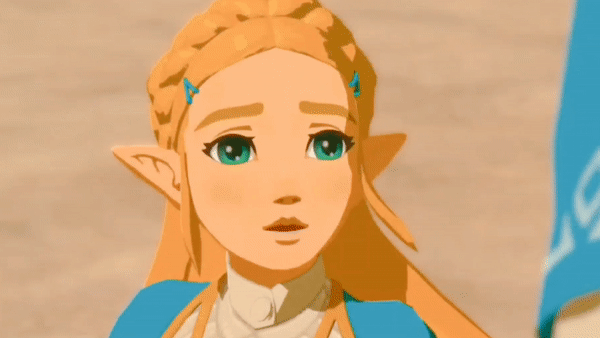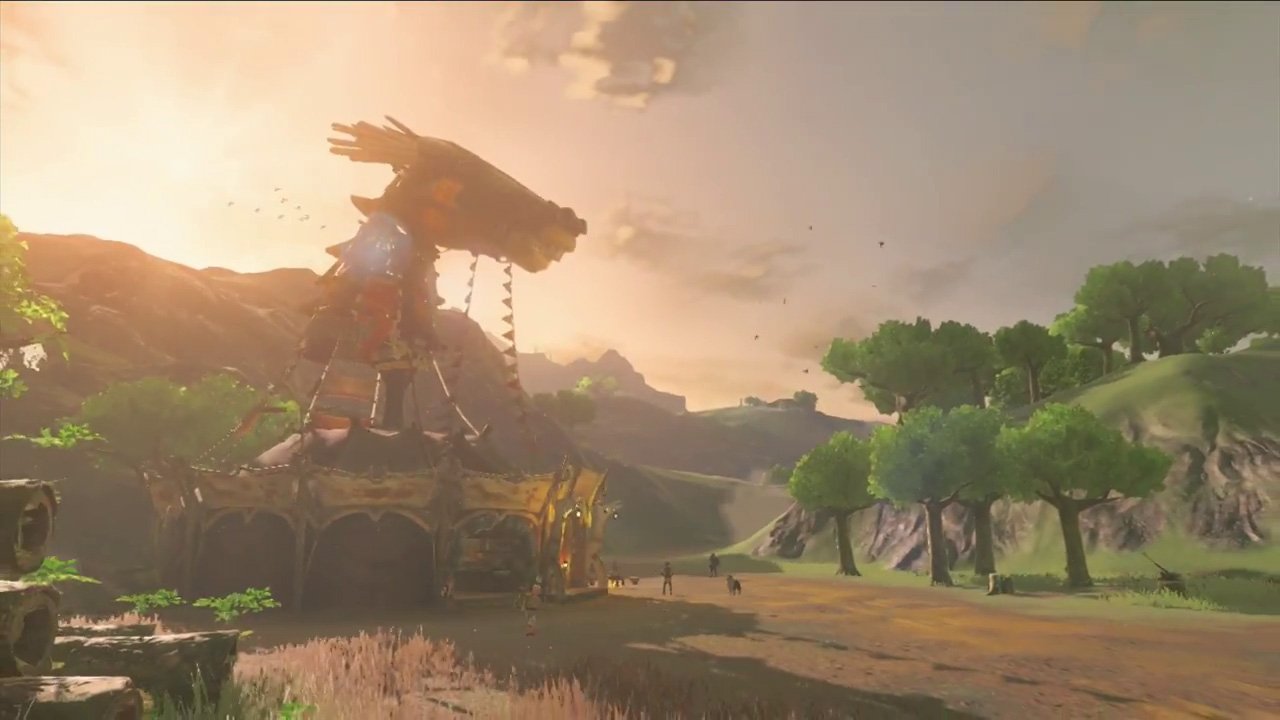Zelda: Music of the Wild
Link’s groundbreaking adventure sounds as good as it plays.
by Scott Rayner
When an ambitious game transcends from an enjoyable pastime into “best-ever-made” territory, it’s naturally going to invite debate of all kinds. With Nintendo’s seminal title The Legend of Zelda: Breath of the Wild, two criticisms are often mentioned by long-term fans of the series: it features no dungeons and no songs.
While I’m firmly in the “this is arguably the best game of all time” camp, I can appreciate the first point. Dungeons do not feature (strictly speaking) in BOTW, as they have been presented in previous entries to the series. Smaller scale “Divine Beasts” and unique puzzles (in the form of ‘Shrines’) replaced larger scale dungeons across the game’s vast map. I may not especially miss the longer, themed dungeons, but I understand why others could. The music critique though, is a different matter entirely. Having spent hundreds of hours in BOTW’s Hyrule since its 2017 release, I assume some must have forgotten just how brilliant the game’s music is. And just how much of it there is. But most significantly, how expertly it’s used across the open-world adventure, which was thirty-five years in the making.
The 211-track listing, which encompasses everything from the “Hyrule field” theme to the “Shield surfing minigame”, is evidence alone that the musical journey provided in BOTW is as vast and deep as the game it helps bring to life (by composer Manaka Kataoka with compositions/arrangements from previous Zelda game composer’s music). (Nintendo)
Piano of the wild
That said, play BOTW for a mere hour or so, and you’d be forgiven for thinking the game was ‘light’ on score. This is because the sound of BOTW is primarily split into two components: open world score (or ‘out in the wild’, rather), and settlement’s theme songs.
The former will for sure make up the bulk of the audio experience for any gamer undertaking Nintendo’s magnum opus (pre-Tears of the Kingdom, at least). And this is where you’ll find one of BOTW’s key breaks in Zelda tradition. Gone are the epic, energetic, looping themes of Hyrule fields of days gone by. Replacing them is a usually subtle, slow, piano background accompaniment. Or sometimes…silence. No music at all, just the sounds of the world around you.
It's a stark contrast for sure, yet it is a very intentional and calculated creative choice. BOTW’s score is constantly working in harmony with every other aspect of the game’s design to deliver its rich experience. Naturally, one of the most important of these is the game’s story and basic premise: Link is traversing this huge, hostile world alone. Utilising moments of silence for this helps to underscore the challenge before Link and thus, the player. It reinforces the loneliness – this is a Link who wakes up to learn that everyone he ever knew is dead, his home is in a post-apocalyptic state, and, that he too, died (just about). None of that exactly suggests ‘play trumpet fanfare’ for 100 hours.
Those piano cues then, begin to make a little more sense. Instead of all-encompassing, they are more suggestive. Used more to set a tone in conjunction with the game’s story and visuals, rather than a continuous score. And cues are often exactly what they are. Glide from a high point in one biome into another, and a piano cue will immediately play, letting you know - for example - that you have just entered an area with a much colder atmosphere. It’s a strategic gameplay nudge too: you better put a shirt on now, or you’ll slowly die in this snowscape that you've entered wearing only shorts.
The mystery of Link’s past (100 years ago) is a significant part of the game’s narrative. Wandering Hyrule, you encounter cutscenes and characters who gradually unveil events shrouded in an amnesic haze to Link/the player. Often, these moments include music that sounds like it’s asking a question. It helps personalise learning the game’s story to the player while deepening the impact of its mysteries. (Nintendo)
Setting the scene
Sparse as these moments may often be, when chosen they reveal something worthwhile. Evoking some of the finest, most descriptive emotions of a Studio Ghibli piano score, BOTW’s musical design is nothing short of elegant. With a gameplay experience on a low average of 50-100 hours, looping any songs for that long - no matter how catchy - would surely diminish their appeal and effect.
The sound of BOTW includes so much more than just a piano score though. The epic surges in the orchestra are present to achieve the expected fantasy heights. But it’s where Nintendo has fun with BOTW’s music that its individualism is cemented. Encounter a mid-tier game boss like a Hinox, and the music accompanying your battle will lean toward jazz. Meanwhile, the “Heat Test minigame” sounds like peak Nintendo silliness.
These moments are a natural juxtaposition against the sacred-feeling music, found inside one of the game’s 120 Shrines. As they underline Link’s place in a story which is far grander than just him, deep and powerful “omms” signify a religious-like poignancy to his task at hand.
When a field battle initiates, a horn blow signifies the start of combat. The music responds by falling into a semi-chaotic jam of piano, violins, and digital scratching, all punctuated by brass instruments. (Nintendo)
Link…open your ears…
Breath of the Wild does exclude a strong musical feature from the series, however: playing the songs yourself. Featured in the likes of Ocarina of Time, the mechanic created a personal connection to the game’s music - by controlling in-game instruments like ocarinas. While this meaningful connection to Zelda music by memorising, and then conducting songs is missing here, the music featured is still deeply personal.
The difference in approach to music from Ocarina of Time to BOTW is front and centre though. What is listed on the latter’s OST as the “Main theme”, is a stark contrast to the catchy update of the NES original found in OOT. Replacing it is a powerful, sweeping orchestral piece, demanding intrigue for adventure as much as it suggests raw emotion. In other words, it’s truly cinematic by comparison. An example of just how the franchise has evolved from the 64-bit era, into near-unprecedented territory with the Wii U/Switch release.
Those older Zelda songs are amazing though, yes. Fortunately, they’re not absent from this game, far from it. The other musical component filling BOTW’s world are the themes that play in the villages, settlements, and general safe harbours of the game.
The series’ constant themes of reinvention, reincarnation, legacy, etc, are felt through BOTW’s gentle inclusion of classic themes. As seen with the original “Main Theme”, used during a memory showing the Princess’ change of heart towards her newly appointed knight, Link. (Nintendo)
Home sweet home
Sold as a true “open world” where you can (technically) go to the end boss soon after beginning your adventure, BOTW does employ some (optional to follow) direction for a player’s first destinations. Choosing to take this guidance, most will likely end up at a horse stable, followed by Kakariko village, then Hateno, or Zora’s domain as initial locations that progress the story. Each reveal character-filled themes, providing a wonderfully location-specific ambience and allowing Link a haven from the outside world.
These pieces bring just as much personality to their setting as any previous Zelda locations have. Kakariko village’s traditional Japanese-sounding instruments channel historical elements from Nintendo’s homeland, which the tribe’s new design takes inspiration from. Rito village brings a dreamy gaze to the windy heights you explore with the winged race. Stables – which you may well encounter while struggling in the wilderness - have a calmness, making you feel like everything is going to be all right. Zora’s domain, perhaps the most relaxing piece in the entire game, expands on the location’s classic theme, matching the majesty and sheer beauty of the game’s aquatic paradise.
The horse Stable theme is a wonderful example of a refreshing spin on a nostalgic classic. In these cheerful havens from the dangerous world, “Epona’s theme” from OOT is sampled into a new piece, soothingly led by accordion and flute. (Nintendo)
The Legend of Ghibli
Two of BOTW’s musical influences are immediately clear, even from before the game’s release. As a game that can often look – and feel – like experiencing a Studio Ghibli epic that you take part in, its music undoubtedly pays homage to the revered Japanese filmmakers. The key connection here originated for me with the release of BOTW’s “Game Awards” trailer.
There’s a distinct similarity to Nausicaa Valley of the Wind’s emotional epic theme “The Legend of the Wind”. An incredibly fitting name, though surely not a complete coincidence, with Shigeru Miyamoto having begun development on the original Legend of Zelda (NES) in 1984 – the same year that Nausicaa was released. Other tracks from the ‘first’ Ghibli film resonate with BOTW (“A Far Away Land” for example). Listen to a medley of the Nausicaa soundtrack, and an audio experience evoking BOTW will await you. (Or even better: click here to listen to it being performed live by the New Japan Philharmonic World Dream Orchestra, conducted by legendary Studio Ghibli composer Joe Hisaishi, no less).
The greatest hits
Of course, one other musical influence is present: the Legend of Zelda series itself. Along with Super Mario, the original 1980s Zelda games featured music so perfectly crafted they’ve been reused, updated, and referenced in every entry to the series since. Breath Of The Wild is no exception. The nostalgic motifs, themes, and melodies are carefully deployed – particularly in cut scenes – adding an emotional depth to the relationship between Link and Zelda. The Princess herself is a character you never actually see or interact with (outside of cutscenes) until the end of the game. BOTW’s piano tricks again work magic in establishing significant emotional value to these moments. The unique inclusion of classic Zelda music during story cutscenes often hints at themes like destiny and underscores the purpose of your role in the game. It draws you back into feeling the relevance of a character fighting to avenge their tragic defeat, one hundred years ago.
BOTW is very careful about how and when it uses the most recognisable piece of music from the Zelda series (the classic theme). It briefly appears in moments such as Kass’ “10,000-Year-Old Legend”, evoking nostalgia and hinting at triumphs both past and yet to come. While also providing the game’s epilogue scene with a feeling of grandeur and fulfilment. Like an end-game reward for achieving full Legend of Zelda. (Nintendo)
The Legend of Zelda is known to evolve through reinvention, and the soundtrack to BOTW is also an evolution. One which certainly accommodates the far longer playing experience but also represents something mature. A transition from video game themes towards a more elegant, evocative score, it stands shoulder to shoulder with its most coveted artistic influences.








